-
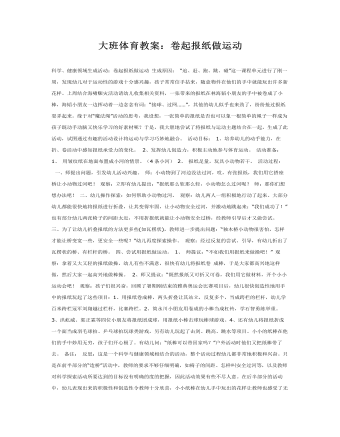
大班体育教案:卷起报纸做运动
上周结合海啸赈灾活动请幼儿收集相关资料,一张带来的报纸在林海韬小朋友的手中被卷成了小棒,海韬小朋友一边挥动着一边念念有词:“接球、过网……”,其他的幼儿似乎也来劲了,纷纷抢过报纸耍弄起来。缘于对“魔法绳”活动的思考,我设想,一张简单的报纸是否也可以象一根简单的绳子一样成为孩子既动手动脑又快乐学习的好素材呢?于是,我大胆地尝试了将报纸与运动主题结合在一起,生成了此活动,试图通过有趣的活动设计将运动与学习巧妙地融合。活动目标: 1、培养幼儿的动手能力,在折、卷活动中感知报纸承受力的变化。 2、发挥幼儿创造力,积极主动地参与体育运动。活动准备: 1、用皱纹纸在地面布置成小河的情景。(4条小河) 2、报纸足量,玩具小动物若干。活动过程: 一、师提出问题,引发幼儿活动兴趣。师:小动物到了河边没法过河,哎,有张报纸,我们用它搭座桥让小动物过河吧!观察:立即有幼儿提出:“报纸那么软那么轻,小动物怎么过河呢?师:那你们想想办法吧!
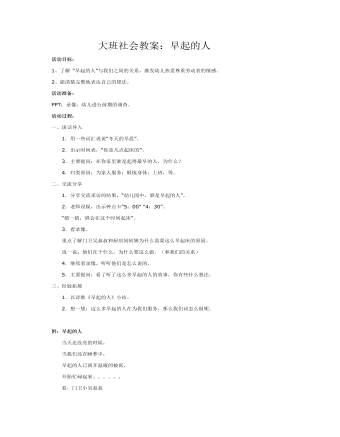
大班社会教案:早起的人
活动准备:PPT;录像;幼儿进行前期的调查。活动过程:一、谈话导入1.用一些词汇说说“冬天的早晨”。2.出示时间表,“你是几点起床的”。3.主要提问:在你家里谁是起得最早的人,为什么?4.归类原因:为家人服务;锻炼身体;上班,等。二、交流分享1.分享交流采访的结果,“幼儿园中,谁是早起的人”。2.老师设疑,出示钟点卡“5:00” “4:30”。“猜一猜,谁会在这个时间起床”。
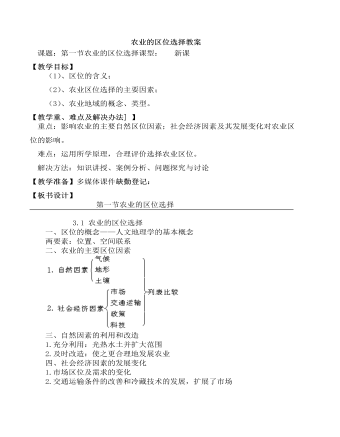
人教版高中地理必修2农业的区位选择教案
【教学目标】 (1)、区位的含义;(2)、农业区位选择的主要因素;(3)、农业地域的概念、类型。【教学重、难点及解决办法] 】重点:影响农业的主要自然区位因素;社会经济因素及其发展变化对农业区位的影响。难点:运用所学原理,合理评价选择农业区位。解决方法:知识讲授、案例分析、问题探究与讨论【教学准备】多媒体课件缺勤登记:三、自然因素的利用和改造1.充分利用:光热水土并扩大范围2.及时改造:使之更合理地发展农业四、社会经济因素的发展变化1.市场区位及需求的变化2.交通运输条件的改善和冷藏技术的发展,扩展了市场
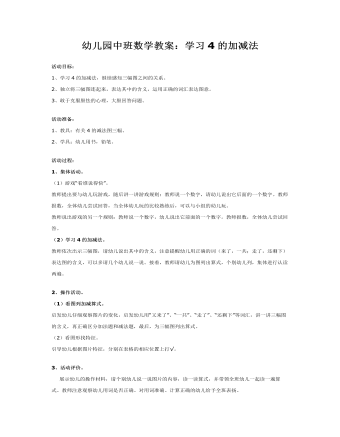
幼儿园中班数学教案:学习4的加减法
2、独立将三幅图连起来,表达其中的含义,运用正确的词汇表达图意。 3、敢于克服胆怯的心理,大胆回答问题。活动准备:1、教具:有关4的减法图三幅。 2、学具:幼儿用书,铅笔。活动过程:1、集体活动。 (1)游戏“看谁说得快”。 教师提出要与幼儿玩游戏,随后讲一讲游戏规则:教师说一个数字,请幼儿说出它后面的一个数字。教师报数,全体幼儿尝试回答,当全体幼儿玩的比较熟练后,可以与小组的幼儿玩。 教师说出游戏的另一个规则:教师说一个数字,幼儿说出它前面的一个数字。教师报数,全体幼儿尝试回答。
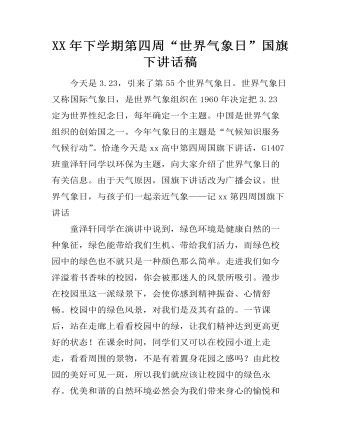
XX年下学期第四周“世界气象日”国旗下讲话稿
今天是3.23,引来了第55个世界气象日。世界气象日又称国际气象日,是世界气象组织在1960年决定把3.23定为世界性纪念日,每年确定一个主题。中国是世界气象组织的创始国之一。今年气象日的主题是“气候知识服务气候行动”。恰逢今天是xx高中第四周国旗下讲话,G1407班童泽轩同学以环保为主题,向大家介绍了世界气象日的有关信息。由于天气原因,国旗下讲话改为广播会议。世界气象日,与孩子们一起亲近气象——记xx第四周国旗下讲话童泽轩同学在演讲中说到,绿色环境是健康自然的一种象征,绿色能带给我们生机、带给我们活力,而绿色校园中的绿色也不就只是一种颜色那么简单。走进我们如今洋溢着书香味的校园,你会被那迷人的风景所吸引。漫步在校园里这一派绿景下,会使你感到精神振奋、心情舒畅。校园中的绿色风景,对我们是及其有益的。一节课后,站在走廊上看看校园中的绿,让我们精神达到更高更好的状态!在课余时间,同学们又可以在校园小道上走走,看看周围的景物,不是有着置身花园之感吗?
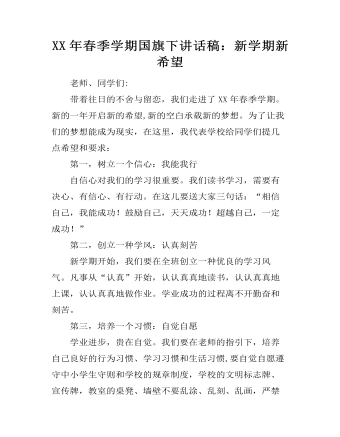
XX年春季学期国旗下讲话稿:新学期新希望
老师、同学们:带着往日的不舍与留恋,我们走进了XX年春季学期。新的一年开启新的希望,新的空白承载新的梦想。为了让我们的梦想能成为现实,在这里,我代表学校给同学们提几点希望和要求:第一,树立一个信心:我能我行 自信心对我们的学习很重要。我们读书学习,需要有决心、有信心、有行动。在这儿要送大家三句话:“相信自己,我能成功!鼓励自己,天天成功!超越自己,一定成功!”第二,创立一种学风:认真刻苦新学期开始,我们要在全班创立一种优良的学习风气。凡事从“认真”开始,认认真真地读书,认认真真地上课,认认真真地做作业。学业成功的过程离不开勤奋和刻苦。第三,培养一个习惯:自觉自愿
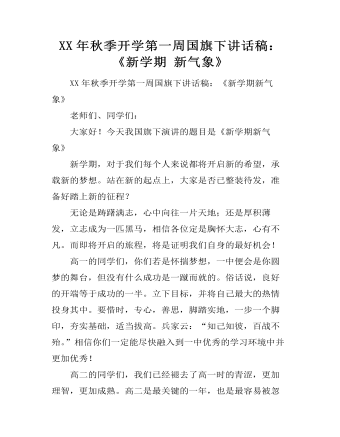
XX年秋季开学第一周国旗下讲话稿:《新学期 新气象》
XX年秋季开学第一周国旗下讲话稿:《新学期新气象》老师们、同学们:大家好!今天我国旗下演讲的题目是《新学期新气象》新学期,对于我们每个人来说都将开启新的希望,承载新的梦想。站在新的起点上,大家是否已整装待发,准备好踏上新的征程?无论是踌躇满志,心中向往一片天地;还是厚积薄发,立志成为一匹黑马,相信各位定是胸怀大志,心有不凡。而即将开启的旅程,将是证明我们自身的最好机会!高一的同学们,你们若是怀揣梦想,一中便会是你圆梦的舞台,但没有什么成功是一蹴而就的。俗话说,良好的开端等于成功的一半。立下目标,并将自己最大的热情投身其中。要惜时,专心,善思,脚踏实地,一步一个脚印,夯实基础,适当拔高。兵家云:“知己知彼,百战不殆。”相信你们一定能尽快融入到一中优秀的学习环境中并更加优秀!高二的同学们,我们已经褪去了高一时的青涩,更加理智,更加成熟。高二是最关键的一年,也是最容易被忽视的一年。要时刻提醒自己,离最终的华山论剑已不再遥远。

人教部编版语文九年级下册梅岭三章教案
(1)看题目。题目中蕴含着诸多信息,如时间、地点、人物、事件以及诗人的心情、诗歌的意境、诗歌的类型等。抓住这一切入点,有助于我们理解诗歌的思想感情。(2)看作者。作品是作者思想情感的具体化,所以,要准确理解诗词,把握作品的思想感情,就不能脱离作者孤立地臆断。作者的生平、写作风格、思想等等,无不影响着作者的情绪,所以,在鉴赏作品时,首先要了解作者的相关背景等。(3)看时代。把握时代风貌特征,把诗歌放在时代背景下评析,才能准确领悟其蕴含的思想感情。(4)看意象。诗歌的创作讲究含蓄、凝练。诗人的抒情往往不是情感的直接流露,而是注重弦外之音、言外之意。写景则借景抒情,咏物则托物言志。因此意象也就是作者的主观感情与客观物象的完美结合,是诗人情感显现的载体。把握诗中的意象,就能参悟意境,理解诗中蕴含的情感。
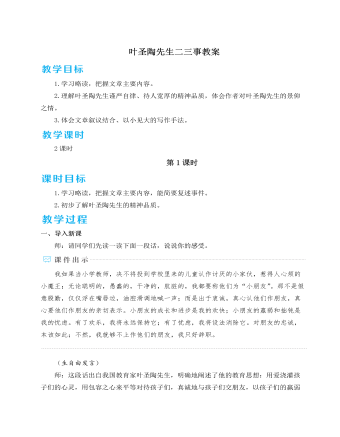
人教部编版七年级下册叶圣陶先生二三事教案
我认识圣陶先生是在成都,1941年春天的一个细雨蒙蒙的上午。那时候我在华西大学中国文化研究所工作,圣陶先生在四川省教育科学馆工作。教育科学馆计划出一套供中学语文教师用的参考书。其中有一本《精读指导举隅》和一本《略读指导举隅》,是由圣陶先生和朱佩弦先生合作编写的。计划里边还有一本讲文法的书,圣陶先生从顾颉刚先生那里知道我曾经在云南大学教过这门课,就来征求我的意见,能否答应写这样一本书。我第一次见到圣陶先生,跟我想象中的“文学家”的形象全不一样:一件旧棉袍,一把油纸雨伞,说话慢言细语,像一位老塾师。他说明来意之后,我答应试试看。又随便谈了几句关于语文教学的话,他就回去了。那时候圣陶先生从乐山搬来成都不久,住家和办公都在郊外。过了几天,他让人送来一套正中书局的国文课本,供我写书取用例句。
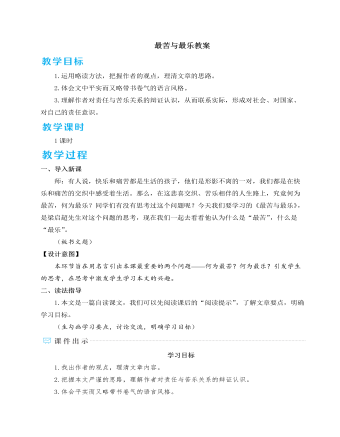
人教部编版七年级下册最苦与最乐教案
梁启超(1873—1929),字卓如,号任公,别号饮冰室主人。广东新会人,思想家、学者。清朝光绪年间举人,戊戌变法(百日维新)领袖之一、中国近代维新派、新法家代表人物。幼年受传统教育,光绪十年(1884)中秀才,1889年中举。后从师于康有为,成为资产阶级改良派的宣传家。维新变法前,协助康有为一起联合在京应试举人发动“公车上书”运动,此后先后领导北京和上海的强学会,又与黄遵宪一起办《时务报》,任长沙时务学堂的总教习,并著《变法通议》为变法做宣传。戊戌变法失败后,逃亡日本。晚年任清华国学研究院导师。他一生著述颇丰,著有《清代学术概论》《中国近三百年学术史》等,著作大多收入《饮冰室合集》。文学知识议论文议论文是一种以议论为主要表达方式,通过摆事实、讲道理,直接表达作者的观点和主张的常用文体。论点、论据和论证,是议论文的三要素。

人教部编版语文八年级下册核舟记教案
《核舟记》是一篇说明性质的文言文,作者在完整而深刻地理解雕刻艺术构思的基础上,合理安排材料,运用简练生动的文字再现了“核舟”的形象。本课教学设计,注重学生自主学习、自主探究、自主拓展,教师予以有效指导。教学中的各个环节环环相扣,思路清晰。在自主学习的过程中,掌握文章的基本内容;在合作学习的过程中,完成文言知识卡片的归纳整理;在探究学习的过程中,通过“找一找”“品一品”两个环节,让学生深入到文本中进行赏析,感知核舟的奇巧,感悟雕刻者技艺的精巧和构思的精妙,学习作者行文的巧妙,体会到文章语言的简洁、准确和生动;在布置作业环节,联系课堂内外,有拓展延伸的阅读,有学以致用的练笔。整个教学设计适应了学生各种能力的发展需要,提高了学生的语文素养。疑难探究《核舟记》一般被视为说明文,但文中包含了大量的描写。对此应该如何理解?首先,说明文是今天我们按照记叙文、说明文、议论文三大文体分类为之做出的界定,而古人的文体分类中并无“说明文”一类,《核舟记》这种记物之文和记游、记亭台楼阁之文都属于“杂记”。
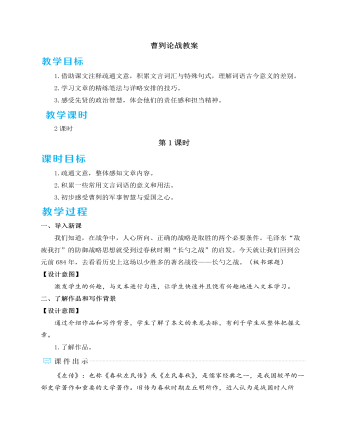
人教部编版语文九年级下册曹刿论战教案
开门见山,免去了君臣相见的繁文缛节的叙述;“齐人三鼓”一句,就包括了齐军的第一次和第二次击鼓进击而鲁军未出击的过程,也写出了齐军依仗数量上的优势企图取胜的急切心理;两个“可矣”写出了鲁军进军的情况;“辙乱”“旗靡”四个字就概括了齐军溃败的具体情况。文章抛开残酷的战争场面,无一字描写,仅一个“齐师败绩”写明战争结果。多四字句,如“曹刿请见”“牺牲玉帛”“一鼓作气”等,读来典雅端庄,辞约而意丰,言简而意明。疑难探究1.如何理解曹刿以平民身份而主动“论战”的行为?曹刿堪称中国古代平民政治家与军事家。他只是鲁国的一介平民,并非“肉食者”,本无机会参与国家大事的商讨和实施。但他凭借着一颗赤诚的爱国之心,积极参与抵御外敌入侵的政治谋划与军事行动,并创造了以弱胜强的战争奇迹。2.请试着从曹刿、鲁庄公、战争这三个角度分别用四个字对文章每一段内容进行概括。从曹刿的角度可以概括为:曹刿论战—曹刿参战—曹刿释疑。从鲁庄公的角度可以概括为:庄公将战—庄公实战—庄公问因。从战争的角度可以概括为:战前准备—战争过程—战胜原因。
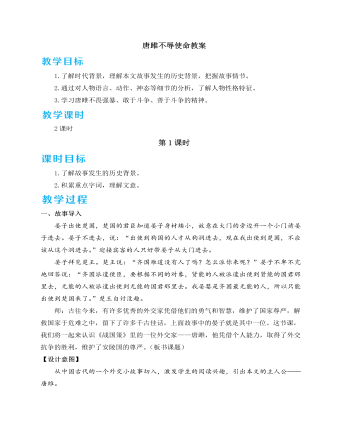
人教部编版语文九年级下册唐雎不辱使命教案
预设 对比与映衬、渲染与烘托。由于文章始终是在人物对话中展开的,人物语言和行为遵循“刺激—反应”模式平行而下,自然形成了对比,造成了映衬互见的效果。如围绕易地问题,就有秦王的欲求与安陵君的坚守,有秦王的无理狡辩与唐雎的据理抗争;在意志较量方面,则有“天子之怒”与“布衣之怒”的对垒。秦王所说的“天子之怒”,唐雎的“未尝闻”;唐雎所说的“布衣之怒”,秦王归之于“免冠徒跣,以头抢地”。一个拒绝回答,非常傲气;一个丑化描述,极为轻蔑。这样,人物形象对比鲜明,相互衬托,将一场正义与非正义的较量真实而生动地展现出来。作者为了追求夸张、强化的效果,多借助人物语言渲染气势、烘托气氛,增强故事的“现场感”。如秦王说“灭韩亡魏”,目的是从气势上压倒对手;唐雎罗列刺客的壮举,也表明了血拼到底的气概。秦王先说“灭韩亡魏”,气势夺人;后说“韩、魏灭亡”,辞格已卑。这些生动的描写,极大地凸显了人物性格。
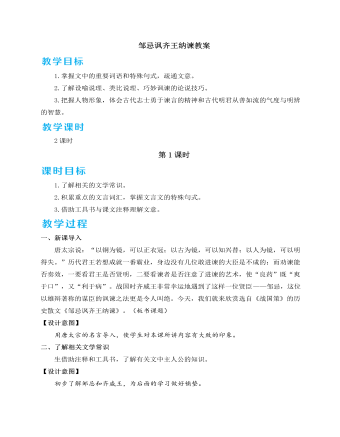
人教部编版语文九年级下册邹忌讽齐王纳谏教案
第二,《战国策》描写人物的性格和活动更加具体细致,也就更显得生动活泼。《左传》描写人物,大抵是简笔勾勒。第三,《战国策》所记的策士说辞,常常引用生动的寓言故事,这也是以文学手段帮助说理的方法。这些寓言,形象鲜明,寓意深刻,又浅显易懂,独立地看也是中国文学宝库中的璀璨明珠。疑难探究除了高超的语言艺术,邹忌劝谏成功还有哪些重要因素?除了高超的语言艺术,邹忌能劝谏成功,还有其他重要的因素。比如:这也与邹忌善于思考、分析的个性和他的担当、责任意识相关。邹忌关心国家大事,一心想寻找恰当时机劝谏齐王。他在生活中经历了“比美”经历,能够深入思考、分析,体察各人的情状心理,并敏锐地由个人体验联系到国家大事,想到齐王所受之蔽,于是果断地进行劝谏。这也离不开齐王广开言路的胸襟和果断行事的理政智慧。齐王听了邹忌的劝谏,马上“下令”,并且分上、中、下三种不同层面赏赐,立刻实施,表现出一位贤明君主的特点。
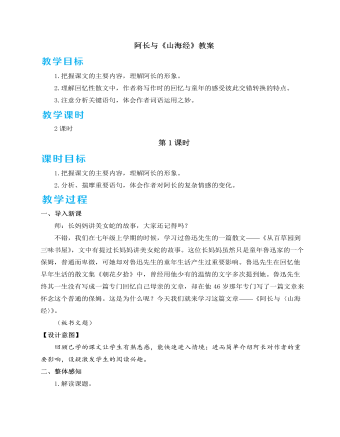
人教部编版七年级下册阿长与《山海经》教案
四、总结存储1.教师总结。纵观作者对阿长形象的刻画,犹如一部连续剧。从“喜欢切切察察”,对“我”过分看管,到睡相粗俗;从“懂得许多规矩”,特别是“元旦的古怪仪式”,到给“我”讲长毛的故事,再到“谋害”隐鼠,多侧面多角度地展现出阿长的个性特点:粗俗好事,迷信无知,却又乐天安命,简单率性。直到阿长给“我”买来《山海经》,先抑后扬的表达效果才充分显现,阿长纯朴善良、仁厚慈爱的品格在前文的衬托下显得格外闪光。而文章末尾,作者饱含深情地祝祷,将全文情感推向高潮。2.课外练笔。在你的童年生活中,有没有像阿长这样给你留下深刻印象的普通人?你怎样看待他们的优缺点?谈一谈你的想法和感受。(200字左右)【设计意图】在学生对课文有了整体的认知之后,教师总结提升。然后要求学生发现生活中普通人的闪光点,发现人性美,并进行课外练笔,有利于学生在实践中巩固技能,以读促写,读写结合,不仅可以加深对课文内容的理解,还能锻炼学生的写作能力。

新人教版高中英语必修3Unit 1 Festivals and celebrations-Discovering Useful Structure教学设计
4.That was an experience that frightened everyone. →That was _____________________. 答案:1. taking 2. being discussed 3. in the reading room 4. a frightening experienceStep 6 The meaning and function of V-ing as the predicative动词-ing形式作表语,它通常位于系动词后面,用以说明主语“是什么”或“怎么样”一种表示主语的特质、特征和状态, 其作用相当于形容词; 另一种具体说明主语的内容, 即主语等同于表语, 两者可互换。The music they are playing sounds so exciting. 他们演奏的音乐听起来令人激动。The result is disappointing. 结果令人失望。Our job is playing all kinds of music. 我们的工作就是演奏各种音乐。Seeing is believing. 眼见为实。Step 7 Practice1. It is ________(amaze) that the boy is able to solve the problem so quickly.2. Buying a car is simply _______(waste) money. 3. Please stop making the noise—it’s getting ________(annoy). 4. complete the passage with the appropriate -ing form.La Tomatina is a festival that takes place in the Spanish town Bunol every August. I think many food festivals are __________ because people are just eating. however, this festival is _________ because people don't actually eat the tomatoes. Instead, they throw them at each other! the number of people ________ part in this tomato fight, can reach up to 20,000, and it is a very __________ fight that lasts for a whole hour. The _______ thing is how clean Bunol is after the tomatoes are washed away after the fight. this is because the juice form tomatoes is really good for making surfaces clean!答案:1. amazing 2. wasting 3. annoying4. boring interesting taking exciting amazing

新人教版高中英语必修3Unit 1 Festivals and Celebrations-Listening &Speaking&Talking教学设计
The theme of this section is “Talk about festival activities and festival experiences”.Festival and holiday is a relaxing and interesting topic for students. This part talks about the topic from the daily life of students’. In the part A ---Listening and Speaking, there are three conversations among different speakers from three countries(Japan, Rio and China), where the speakers are participating in or going to participate in the festivals and celebrations. So listening for the relationship among them is a fundamental task. Actually, with the globalization and more international communication, it is normal for Chinese or foreigners to witness different festivals and celebrations in or out of China. In the Conversation 1, a foreign reporter is interviewing a Japanese young girl who just had participated in the ceremony of the Coming-of-Age Day on the street and asking her feeling about the ceremony and the afterwards activities. Conversation 2, Chinese girl Li Mei is witnessing the Rio Carnival for the first time, and her friend Carla gives her some advice on the costumes which enables her to match with the carnival to have a good time. Conversation 3, a Chinese guide is showing a group of foreign visitors around the Lantern Festival and introducing the customs of the festival to them. The three conversations have a strong vitality and insert the festival and cultural elements from different countries. So perceiving the festivals and cultures from different countries is the second task. At the same time, the scripts also insert the targeted grammar --- v-ing as attributive and predicative, which students can perceive and experience in a real context and make a road for the further study. That is the third task. In the Part B--- Listening and Talking, the theme is “Talk about festival experience”, which is the common topic in our daily conversations. During the conversation, Song Lin, a Chinese student, asked Canadian friend Max about how to spend Christmas. In the conversation, Song Lin talked about experience and the feelings during the Chinese Spring Festival, during which there are not only some enjoyable things but some unpleasant things. After the listening, perhaps students find there are some similarities between Christmas and the Chinese Spring Festival as there are some differences in the origins and celebrations. For example, people always visit friends and relatives, decorate their houses, have a big dinner together, chat and give presents to each other.

新人教版高中英语必修3Unit 1 Festivals and Celebrations-Reading for writing教学设计二
Step 3 Analyzing article structureActivity 31. Teachers raise questions to guide students to analyze the chapter structure of this diary and think about how to describe the festival experience. (1)What should be included in the opening/body/closing paragraph(s)?(2)How did the writer arrange his/her ideas?(3)What kind of interesting details did the writer describe?(4)How did the writer describe his/her feelings/emotions during the event?2. Students read and compare the three sentence patterns in activity 2. Try to rewrite the first paragraph of the diary with these three sentence patterns. After that, students exchange corrections with their partners. Such as:●This was my first time spending three days experiencing the Naadam Festival in China’s Inner Mongolia Autonomous Region and it was an enjoyable and exciting experience. ●I'll never forget my experience at the Naadam Festival because it was my first time to watch the exciting Mongolian games of horse racing, wrestling, and archery so closely. ●I'll always remember my first experience at the Naadam Festival in China’s Inner Mongolia Autonomous Region because it was so amazing to spend three days witnessing a grand Mongolian ceremony. Step 4 Accumulation of statementsActivity 41. Ask the students to read the diary again. Look for sentences that express feelings and emotions, especially those with the -ing form and the past participle. Such as:● …horse racing, wrestling, and archery, which are all so exciting to watch. ● some amazing performances● I was surprised to see…● I was a little worried about. . . ● feeling really tiredOther emotional statements:●I absolutely enjoyed the archery, too, but the horse races were my favourite part. ●I'm finally back home now, feeling really tired, but celebrating Naadam with my friend was totally worth it. ●He invited me back for the winter to stay in a traditional Mongolian tent and cat hot pot. I can’t wait!2. In addition to the use of the -ing form and the past participle, the teacher should guide the students in the appreciation of these statements, ask them to memorize them, and encourage them to use them reasonably in writing practice.

新人教版高中英语必修3Unit 1 Festivals and Celebrations-Reading for Writing教学设计一
The topic of this part is “Write about your festival experience”.During the Listening and Speaking and Talking, students are just asked to say out their festival experiences such as the Spring Festival, Mid-autumn Day, but this part students will be asked to write down their own festival experiences. During the reading part, it introduces the Naadam Festival in Inner Mongolia Autonomous Region, which can give students a good example to imitate. Students not only learn the festival, but touch and feel the Inner Mongolian’s character, the spirit and cultural atmosphere, which can help students form the cultural awareness and learn to enjoy and value the diversity of Chinese culture.Concretely, the dairy tells the experience that the author spent the Naadam Festival in Inner Mongolia Autonomous Region with his/her friend. The structure is clear. In the opening paragraph, it introduces the topic of the Naadam Festival and the whole feeling. Then it introduces the items of the festival like the ceremony, wrestling and horse racing. Finally, it summarizes this experience. Because this part is a travel journal, we must guide students pay more attention to these details: 1. use the first person. 2. use the past tense to tell the past thing and use the present or future tense to describe the scenery. 3. use the timeline to tell the development. 4. be careful for the author’s psychology, emotion and feeling, etc.1. Read quickly to get main idea; read carefully to get the detailed information about Naadam Festival.2. Learn the structure of the reading article and language.3. Write an article about a festival experience4. Learn to use the psychology, emotions and feeling in the writing.1. Write an article about a festival experience.2. Use the structure of the reading article and language.

新人教版高中英语必修3Unit 2 Morals and Virtues-Discovering Useful Structure教学设计
1. 表示时间。Hearing these stories, I’m skeptical about the place. = When I heard these stories. . . 2. 表示原因。Not knowing his address, I can’t send this book to him. = Because/Since/As I don’t know his address. . . 3. 表示结果。His father died, leaving him a lot of money. =. . . and left him a lot of money4. 表示条件。Going straight down the road, you will find the department store. = If you go straight down the road. . . 5. 表示让步。Being tired, they went on working. =Although they were tired. . . 6. 表示行为方式、伴随情况或补充说明。He lay on the grass, staring at the sky for a long time. =. . . and stared at the sky for a long time注意:非谓语动词作状语时, 如所提供的动词不能和句子中的主语保持一致, 动词-ing形式必须有自己的逻辑主语, 通常由名词或代词来担任, 这就是独立主格结构。The last bus having gone, we had to walk home. (having gone的逻辑主语是the last bus, 而不是we)Weather permitting, the football match will be played on Friday. (permitting的逻辑主语是time, 而不是the football match)Step 7 Practice1. ________(study) hard, you are sure to get first prize. 2. People use plastic in their daily life, _______(leave) large amounts of waste. 3. ________(work) hard at your lessons, you are to succeed. 4. The old man, ____________(work) abroad for twenty years, is on the way back to his motherland. 5. ______________(finish) his homework, he was playing on the playground. Answers: 1. Studying 2. leaving 3. Working 4.having worked 5. Having finishedStep 8 HomeworkFinish the homework on Page 22.







